Types of Watches You Should Know About

-
A Wide Variety of Watches
-
Analog Watches
-
Digital Watches
-
Dress Watches
-
Chronographs
-
GMT watches
-
Dive watches
-
Pilot / Aviation watches
-
Field watches
-
Smart watches
For both formal and casual occasions, a watch is a vital part of your appearance. Many different types of watches are available. But how do you determine which one to purchase with so many options? Discover yourself about the different kinds of watches just on market so that you can choose the timepiece of your dreams.
A Wide Variety of Watches
Analog Watches
It is common for an analogue watch to include a mechanism that makes the "ticking" sound as well as simultaneously moving the hands that indicate the time in seconds, hours, and minutes.
The hour hand appears shorter than the minutes, while the seconds hand is indeed the thinnest and longest on the dial. If you're looking at a watch's face, you're looking at its dial. This timepiece has hands that point in the direction of numeral or hour markers that are set in the right sequence. There are two types of watches: digital and analogue. Digital watches utilize electricity to power the display, while analogue watches employ mechanical components to turn the hands.
These vintage watches are still extensively used because of the sophisticated and elegant displays they have.
Digital Watches
Digital watches, which show the time digitally, have a more contemporary appearance. Digital wristwatches have either LED or LCD displays on their dials. It's no secret that digital watches are indeed the multi-featured, tech-savvy cousins of analogue ones.
Digital watches are perfect for those who lead active, fast-paced lives and need a watch that can keep up with them.
Dress Watches
It is considered a dress watch if paired with either a formal suit as well as tuxedo in the traditional sense. Casual wear like a polo shirt and jeans, however, go as well with it these days.
The elegance of it is maybe the most important aspect. Most dress watches just feature a second hand and just a date window as a complication, if any at all. For a formal dress watch, simplicity and elegance are inseparable.
Dress watches are often combined with quality leather straps and polished or dual polished cases. You may wear any of these straps with your dress watch, whether you're headed to a formal occasion or a more casual one.
Chronographs
If you're looking for a quality timepiece, go no further than a chronograph watch. They're beautiful works of art that can be utilized for much more than just keeping track of the passing of time.
The basic idea behind modern chronographs is the same as it was in the 1800s. A stopwatch, or "chronograph," is all it is at its most basic. As a result of this, current chronographs include a number of functions that makes them more helpful than a stopwatch. Most chronographs have three buttons on the right side of the display and at least a couple dials on the face.
GMT watches
At "0" on the 24-hour worldwide time zone scale, GMT refers as Greenwich Mean Time (GMT). Timepieces that show both 24-hour and 12-hour time are known as GMT watches.
Adding or removing time from GMT gives you the time in any part of the globe, regardless of where you are in the world. Many individuals now utilize GMT hands to display the time in a time zone other than their own country's standard time zone, or to provide an AM/PM time display.
The 24-hour hands can be simply aligned to indicate GMT time, which was the original purpose of the GMT watch. If you know your present location's time zone, you may adjust the 12-hour hands to match the 24-hour hands.
Dive watches
Among men's timepieces, the dive watch has a classic look. It is elegant, sleek, and very useful.
Diving watches are classified according to a variety of parameters. Starting with a water-resistant watch that can withstand being submerged up to a depth of 100 meters. 200-300 meters is the norm for most diving watches; 100 meters is considered the minimum. An additional need for watches is that they be resistant to magnetic fields, chemicals, and shocks.
The time spent diving must be monitored somehow as well. While this may be digital, the spinning bezel of mechanical timepieces is the most common place to find it. Divers needed to know how long they had been submerged, and this was a huge help in accomplishing this goal.
Pilot / Aviation watches
During the early 20th century, pilots discussed watch technology. For the most part, men used pocket watches back then, and wristwatches weren't as well accepted as they are now. Today, aviator watches were on high demand because of their practical beauty and clear legibility, making them quite popular.
Indicators that are easy to see set pilot watches apart from the crowd. A Pilot's watch has a very simple dial. Most watches include Roman or Arabic numbers and eye-catching luminous hands so that they may be easily viewed even in the dark.
Field watches
Field watches, formerly known as "trench watches," are basic military timepieces used by troops during World War I. Today's field watches maintain the same look and feel as their vintage counterparts. As a modern field watch transitions from usefulness to a multi-functioning daily watch for the modern man, nothing has changed except for the inclusion of luxury components.
For the most part, a field watch features a simple casing. The face of a typical field watch is typically black, with light-colored hands, and offers just a few additional features to aid the user in specialized field-related activities.
Smart watches
A wrist-worn smartphone-like gadget, a smart watch is becoming more popular. Many smart watches are linked to a smartphone that alerts the user of voice calls, e-mails, and notifications from apps. The ability to make phone calls is available on several smart watches.
Wearers of this smart watch may choose to utilize the watch's touch-sensitive screen or physical buttons to control it. Pedometers and cardiac monitors may help people monitor their own health.
If you find this article helpful, you might want to check out my other posts :
>> Different Types of Watch Materials
To learn more about watches :
>> Welcome to Our Learning Hub
To see my recommendations of watches, cases, and watch straps :
>> Explore Watches and More with TimeFAQ!
To see my reviews of watches :
-
A Wide Variety of Watches
-
Analog Watches
-
Digital Watches
-
Dress Watches
-
Chronographs
-
GMT watches
-
Dive watches
-
Pilot / Aviation watches
-
Field watches
-
Smart watches









